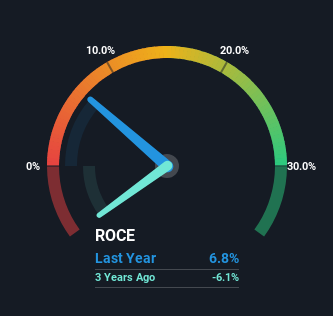- India
- /
- Auto Components
- /
- NSEI:KALYANIFRG
Capital Allocation Trends At Kalyani Forge (NSE:KALYANIFRG) Aren't Ideal
Ignoring the stock price of a company, what are the underlying trends that tell us a business is past the growth phase? Businesses in decline often have two underlying trends, firstly, a declining return on capital employed (ROCE) and a declining base of capital employed. Basically the company is earning less on its investments and it is also reducing its total assets. In light of that, from a first glance at Kalyani Forge (NSE:KALYANIFRG), we've spotted some signs that it could be struggling, so let's investigate.
Understanding Return On Capital Employed (ROCE)
If you haven't worked with ROCE before, it measures the 'return' (pre-tax profit) a company generates from capital employed in its business. The formula for this calculation on Kalyani Forge is:
Return on Capital Employed = Earnings Before Interest and Tax (EBIT) ÷ (Total Assets - Current Liabilities)
0.068 = ₹93m ÷ (₹2.4b - ₹1.0b) (Based on the trailing twelve months to December 2023).
Therefore, Kalyani Forge has an ROCE of 6.8%. Ultimately, that's a low return and it under-performs the Auto Components industry average of 15%.
See our latest analysis for Kalyani Forge

Historical performance is a great place to start when researching a stock so above you can see the gauge for Kalyani Forge's ROCE against it's prior returns. If you want to delve into the historical earnings , check out these free graphs detailing revenue and cash flow performance of Kalyani Forge.
What Does the ROCE Trend For Kalyani Forge Tell Us?
We are a bit worried about the trend of returns on capital at Kalyani Forge. Unfortunately the returns on capital have diminished from the 16% that they were earning five years ago. Meanwhile, capital employed in the business has stayed roughly the flat over the period. Companies that exhibit these attributes tend to not be shrinking, but they can be mature and facing pressure on their margins from competition. If these trends continue, we wouldn't expect Kalyani Forge to turn into a multi-bagger.
On a separate but related note, it's important to know that Kalyani Forge has a current liabilities to total assets ratio of 42%, which we'd consider pretty high. This effectively means that suppliers (or short-term creditors) are funding a large portion of the business, so just be aware that this can introduce some elements of risk. Ideally we'd like to see this reduce as that would mean fewer obligations bearing risks.
The Key Takeaway
In the end, the trend of lower returns on the same amount of capital isn't typically an indication that we're looking at a growth stock. However the stock has delivered a 68% return to shareholders over the last five years, so investors might be expecting the trends to turn around. Regardless, we don't feel too comfortable with the fundamentals so we'd be steering clear of this stock for now.
If you'd like to know more about Kalyani Forge, we've spotted 4 warning signs, and 1 of them shouldn't be ignored.
While Kalyani Forge may not currently earn the highest returns, we've compiled a list of companies that currently earn more than 25% return on equity. Check out this free list here.
Valuation is complex, but we're here to simplify it.
Discover if Kalyani Forge might be undervalued or overvalued with our detailed analysis, featuring fair value estimates, potential risks, dividends, insider trades, and its financial condition.
Access Free AnalysisHave feedback on this article? Concerned about the content? Get in touch with us directly. Alternatively, email editorial-team (at) simplywallst.com.
This article by Simply Wall St is general in nature. We provide commentary based on historical data and analyst forecasts only using an unbiased methodology and our articles are not intended to be financial advice. It does not constitute a recommendation to buy or sell any stock, and does not take account of your objectives, or your financial situation. We aim to bring you long-term focused analysis driven by fundamental data. Note that our analysis may not factor in the latest price-sensitive company announcements or qualitative material. Simply Wall St has no position in any stocks mentioned.
About NSEI:KALYANIFRG
Kalyani Forge
An engineering company, manufactures and sells forged, machined, and assembled products in India.
Solid track record with slight risk.
Market Insights
Community Narratives



